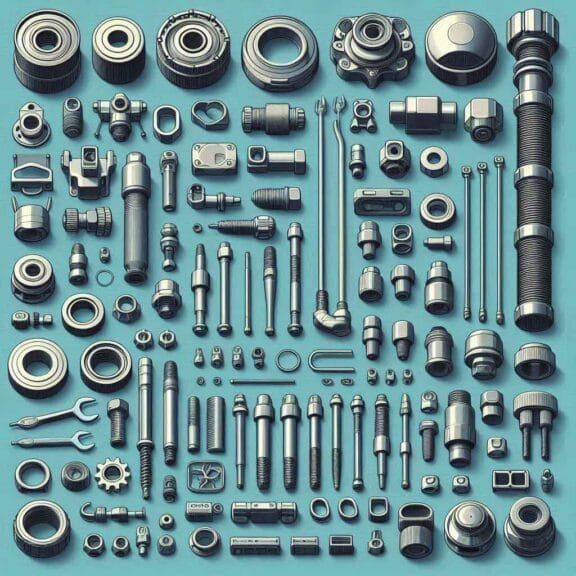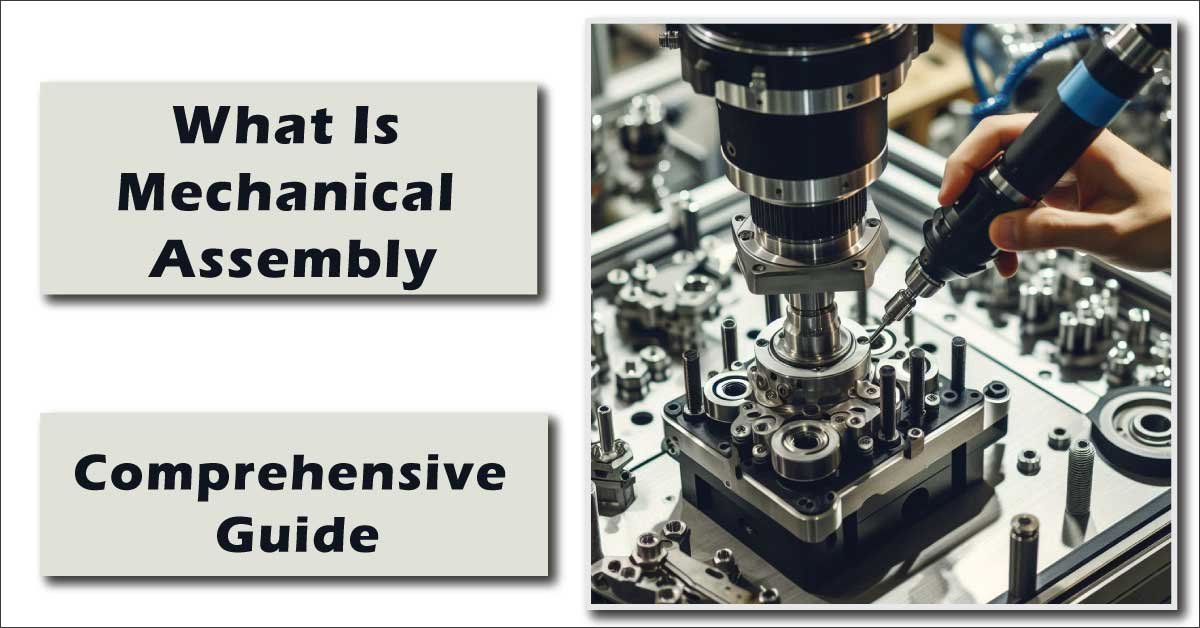Mechanical assembly is the process of putting together individual components, such as parts, fasteners, and fittings, to create a functional product or system. It is used across various industries, including automotive, aerospace, and electronics, to manufacture everything from simple devices to complex machinery. The process can involve manual or automated techniques like welding, soldering, or adhesive bonding to ensure that parts are securely and precisely connected.
Introduction About What Is Mechanical Assembly
Mechanical assembly is a fundamental aspect of modern manufacturing, crucial for creating everything from simple household products to complex machines like cars and airplanes. It refers to the process of combining different components, parts, and materials to form a functional product. Whether you’re driving a car or using an electronic device, mechanical assembly plays a key role in how these products are created and operate.
In various industries such as automotive, aerospace, electronics, and manufacturing, the importance of mechanical assembly cannot be overstated. It allows industries to create everything from small gadgets to large industrial machinery with precision and efficiency. This guide explores what mechanical assembly is, its components, processes, and significance across different sectors. By the end, you’ll have a deep understanding of what mechanical assembly involves and why it’s so critical in today’s industrial landscape.
What Is Mechanical Assembly? An Overview
At its core, mechanical assembly is the process of putting together individual components to form a larger, functional product or system. These components can range from small parts like screws and bolts to large pieces of equipment like engines or gearboxes. The process involves carefully combining these parts, often using tools, fasteners, or adhesives, to create a final product that performs a specific function.
There are various types of mechanical assemblies, ranging from simple to complex. A simple assembly might involve putting together a piece of furniture, whereas a more complex mechanical assembly could involve creating an airplane engine with thousands of parts. Regardless of complexity, the goal is always the same: to ensure that the parts fit together precisely and work as intended.
Mechanical assembly is integral to product manufacturing and machine building, enabling companies to mass-produce items with consistent quality and performance. Without it, the machines and devices we rely on daily wouldn’t function as they do.
Key Components Involved in Mechanical Assembly
Mechanical assembly is not just about putting parts together; it’s about selecting the right components to ensure strength, durability, and functionality. Let’s look at some of the key components involved.
Fasteners: What Is Mechanical Assembly Without Them?
Fasteners, such as bolts, screws, and rivets, are essential in holding parts together in mechanical assembly. These components provide the structural integrity that ensures the assembled product remains intact and functional. Whether it’s a car chassis or a piece of furniture, fasteners are chosen based on the material being used, the strength required, and the environment in which the product will be used.
Choosing the right fastener is crucial. In high-stress applications like automotive or aerospace, where parts are subjected to extreme forces, high-strength fasteners made of durable materials like steel or titanium are essential. In contrast, in consumer electronics, smaller fasteners may be used, but precision is key to ensure the delicate components stay in place.
Fittings and Connectors: Integral to Understanding What Is Mechanical Assembly
Fittings, connectors, and joints play a crucial role in ensuring that different parts of the assembly fit together seamlessly. These components provide the necessary alignment and stability, allowing for the smooth operation of the assembled product. Whether it’s a hydraulic fitting in a piece of machinery or an electrical connector in a computer, these components ensure that parts work together efficiently.
Connectors also ensure that parts are easy to assemble and disassemble when needed, making maintenance and repair more manageable. For example, in the automotive industry, connectors allow different systems, such as the fuel system or braking system, to be assembled and replaced quickly and effectively.
The Mechanical Assembly Process: Step-by-Step
To truly understand what is mechanical assembly, we must explore the process in detail. The steps involved in mechanical assembly vary depending on the product and industry, but the principles remain consistent.
What Is Mechanical Assembly Without Proper Planning?
The first step in any mechanical assembly process is planning. Proper planning ensures that the assembly is efficient, cost-effective, and meets all technical requirements. During this stage, engineers and designers determine how the various components will fit together, how they will be fastened, and what tools or machinery will be needed.
Computer-aided design (CAD) software is often used during the planning stage to model the assembly. CAD allows engineers to create a virtual representation of the product and simulate how the parts will interact. This helps identify potential issues, such as misalignment or interference, before production begins, saving time and resources.
Assembly Techniques in Detail
There are several techniques used in mechanical assembly, depending on the product and the desired outcome. These techniques can be broadly divided into manual and automated assembly.
Manual Assembly: In manual assembly, workers use tools to put the parts together. This method is often used for smaller production runs or when precision and attention to detail are required. For example, in the watchmaking industry, manual assembly is crucial for ensuring that the delicate components are carefully put together.
Automated Assembly: In larger production environments, such as automotive manufacturing, automated assembly lines are used to speed up the process. Robots and machines perform tasks like welding, fastening, and placing components, ensuring that the assembly process is consistent and efficient.
Some common assembly techniques include:
Welding: Welding involves fusing two or more parts together using heat. It is commonly used in industries like automotive and aerospace, where strong, permanent joints are required.
Soldering: Soldering is similar to welding but is typically used in electronics to join smaller components, such as circuit boards.
Adhesive Bonding: Adhesive bonding involves using glue or other bonding agents to hold parts together. This technique is often used in industries like packaging or consumer goods, where fasteners might not be suitable.
Discover the importance of preventive maintenance in this comprehensive guide. Learn how regular upkeep can extend equipment lifespan, reduce downtime, and prevent costly repairs. Dive into the full post for insights!
Common Applications of Mechanical Assembly
Mechanical assembly is used in a wide range of industries, from automotive to electronics. Let’s explore some of the most common applications.
Automotive Industry: In the automotive industry, mechanical assembly is used to create everything from engines to chassis to electrical systems. Thousands of components are assembled to create a functional vehicle, with precision and safety being of the utmost importance.
Aerospace Industry: Aerospace relies heavily on mechanical assembly to build aircraft, rockets, and satellites. Due to the extreme conditions these products face, such as high-speed travel and intense temperature fluctuations, the assembly process must be precise and reliable.
Consumer Goods Manufacturing: From kitchen appliances to smartphones, mechanical assembly is essential in the creation of consumer goods. The assembly process ensures that products are not only functional but also aesthetically pleasing and easy to use.
Challenges and Innovations in Mechanical Assembly
Despite its many advantages, mechanical assembly comes with its challenges. Precision is one of the biggest hurdles, as even small deviations can lead to malfunctions or failures. Tolerances must be tightly controlled to ensure that all components fit together perfectly.
Material compatibility is another challenge. Different materials have different properties, such as expansion rates or chemical resistance. When assembling components made from different materials, these factors must be considered to prevent issues like corrosion or mechanical failure.
Innovations are continuously being introduced to address these challenges. Robotics and artificial intelligence (AI) are revolutionizing the assembly process, allowing for greater precision and speed. Robots can now perform tasks like welding, fastening, and part placement with extreme accuracy, reducing the risk of human error.
In addition, AI is being used to optimize the assembly process. By analyzing data from previous assemblies, AI can predict potential issues and suggest improvements, leading to more efficient and reliable assembly processes.
Explore seven free mechanical design software options that every engineer should know. Enhance your design process without breaking the bank. Check out the full post to find the best tools for your needs!

Conclusion
In conclusion, mechanical assembly is a vital process in modern manufacturing, enabling industries to create functional products by combining various components. Understanding what is mechanical assembly is essential for appreciating its significance in industries ranging from automotive to consumer goods.
By carefully selecting the right components, employing efficient assembly techniques, and embracing new innovations, companies can ensure that their products meet the highest standards of quality and performance. Whether it’s a simple household item or a complex piece of machinery, mechanical assembly is the backbone of product manufacturing.
Discover innovative mechanical workshop layout ideas designed for maximum efficiency. Learn how to optimize space, improve workflow, and enhance productivity. Read the full post for practical tips and insights!

